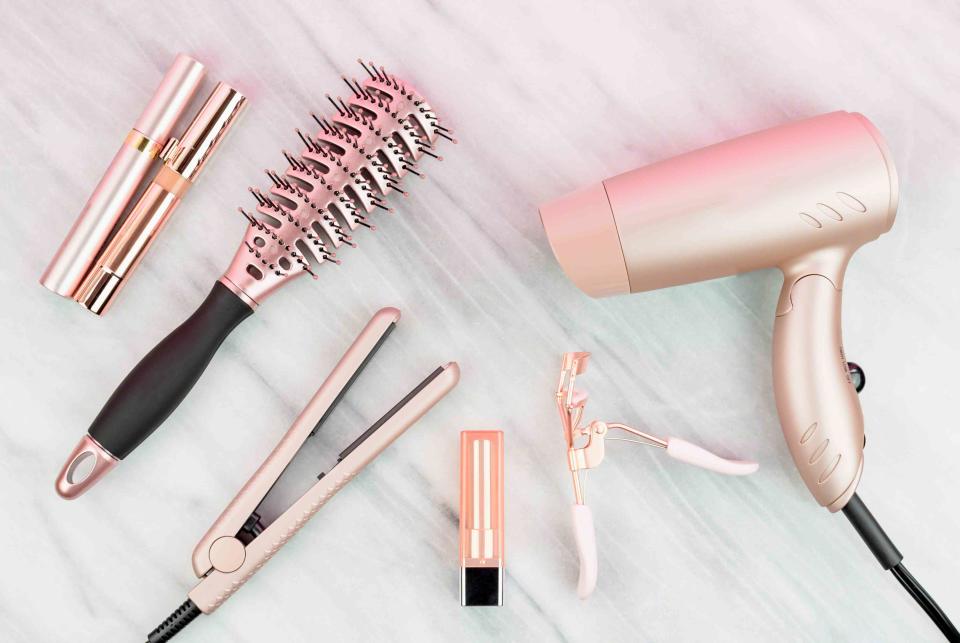5 Habits That Are Secretly Damaging Your Hair
It’s the little things that can take a toll on your tresses.

Kristen Prahl/Getty Images
There are certain things that you (hopefully) already know are no good for your hair. We’re talking things like using hot tools without a heat protectant, forgoing regular trims, overdoing it on the highlights…you get the picture. But did you know that there are some other, much sneakier and less obvious, culprits that can also be doing a number on your strands? Here, stylists weigh in on five of these secretly damaging habits —plus what to do instead.
Sleeping with Wet Hair
If you’re a nighttime showerer/hair washer, it can be tempting to hit the sack while your strands are still wet, but resist the urge. “Sleeping with wet hair can cause the cuticle, the outermost layer of the hair, to lift up, which can lead to split ends and breakage,” explains Katelyn Ellsworth, a natural color and extension specialist and founder of The Roslyn in San Diego. Couple that with the fact that the friction created from the hair rubbing against your pillowcase all night can create frizz and tangles, and you have a real recipe for disaster. (Ellsworth notes that, while this can happen with all hair types, those with fine hair are even more susceptible.) At the very least, blow-dry your hair until it’s just slightly damp, suggests stylist Annagjid ‘Kee’ Taylor of Deeper Than Hair. Then, style it in a low, loose braid so that it doesn’t drag across your pillow while you’re sleeping, she adds.
Brushing Wet Hair
Speaking of wet hair, going to town with a brush immediately post-shower is another potential pitfall. “Your hair is at its weakest when it is wet. Brushing, or being aggressive with your hair while it’s wet, can lead to breakage, split ends, and damage,” cautions stylist Andrew Fitzsimons, founder of the eponymous haircare line.. That being said, it is important, especially for curly textures, to brush it out while it’s damp; the key is in the technique. He recommends first using a microfiber towel to gently squeeze out excess water; this fabric is gentler and less rough on the hair then traditional terry cloth. If you have curly hair, Fitzimons says using a Denman brush will help gently detangling while still defining your curls. Otherwise, use a wide-tooth comb to gently comb through the hair once it’s almost dry.
Not Cleaning Your Hair Tools
Everyone talks about the importance of cleaning makeup brushes, but what about your hair brushes (and other tools)? All of the dead skin cells, oils, and product residue build up on the brush as you use it will just end up back in your hair if you don’t clean it, cautions Fitzsimons. You don’t have to clean it daily, even once a week (using warm water and a gentle shampoo) is sufficient, he adds.
And FYI, your curling irons and straighteners need to be cleaned, too. The product residue that accumulates on these tools can lead to a build-up of grease and bacteria, not to mention even cause the metal to start to erode over time, Taylor notes. Aim to clean these monthly, using an alcohol wipe to wipe down the surfaces—when the tool is turned off and cool, of course.
Skimping on Sun Protection
Believe it: It’s just as important to protect your strands from the sun as it is to protect your skin. First and foremost, sun exposure can mess with your color, most often pulling out unwanted yellow tones in blondes and brunettes, says Ellsworth. Plus, UV rays can also damage hair cells, potentially accelerating hair thinning and damage, Taylor notes. Happily, the remedy is simple: Wear a hat anytime you’re in the sun and/or use a hair product that contains SPF, says Ellsworth.
Making Your Ponytail Too Tight
We love the look of a sleek, snatched pony as much as anyone else, but if a tight ponytail is your go-to look day in and day out, you may want to reconsider. “While ponytails are easy and convenient, pulling your hair back too tightly applies too much tension on the scalp and can lead to hair loss around the hairline and temples,” explains Fitzsimons, who adds that those with fine or thin hair are especially at risk. The good news: You don’t need to avoid ponytails completely, he says. Just make sure the styles that are gentler on your hair—think a low bun or loose braid—are also part of your regular rotation.
For more Real Simple news, make sure to sign up for our newsletter!
Read the original article on Real Simple.


